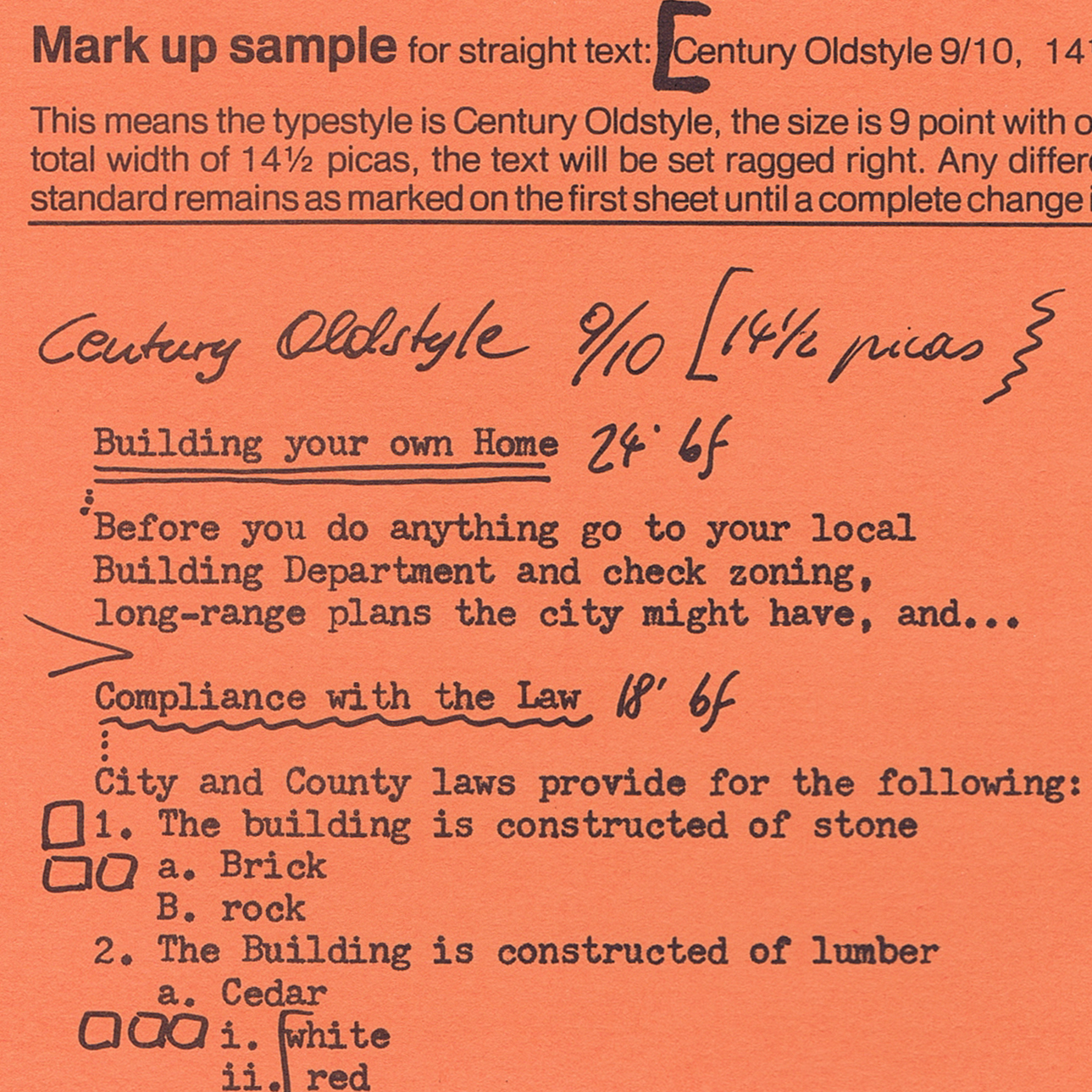Setting type on Skid Row
The new location of Franklin Press was on the first block of the street that gave the world the phase “Skid Row.” Yesler Way was the original Skid Road, literally a road running straight downhill from the forested slopes above nascent Seattle, down which the cut logs would be skidded to the sawmills at the bottom. The less resilient of the hard-living, hard-drinking loggers would also skid downhill, metaphorically and almost literally, to pool in the bars on the flats by the waterfront. While those flats had been built up after the fire of 1889 and the streets were lined with brick buildings in the Richardson Romanesque style, Pioneer Square retained its Skid Row reputation for much of the 20th century.
When Franklin Press re-opened at 81 Yesler Way, it was in one of the storefronts under the fleabag Hotel Yesler, facing a tiny Italian restaurant across the street, the Trattoria Mitchelli. The Trat originally occupied only a narrow corner space, with a magnificent old wooden horseshoe-shaped bar and a couple of small tables under the front window. Those of us who worked at Franklin Press often ate lunch across the street at the Trat; we could easily see when Jim came back from his own lunch break. The food was good, and the wait staff had attitude. I was often impressed by the staff’s ability to avoid eye contact as they moved past behind the bar — an impressive feat, given that the narrow bar put the customers only arm’s length away. But they were friendly to regulars. One of the waitresses in those days was an aspiring singer with a magnificent voice: Julie Cascioppo, who later went on to a successful career in cabaret in Seattle. (I like to think that I had a slight influence in dissuading her from adopting a stage name; she was afraid that nobody would know how to pronounce “Cascioppo” [Cash-yee-OH-poh].)
Cockroaches aren’t common in Seattle, but they were endemic in some of the old buildings in Pioneer Square. I can remember watching an unusually large roach climb up the side of the Comp IV I was typing on — large enough that I wondered if it had come off some ship in the harbor, since it was much bigger than anything I was used to seeing.
The building also had rats. I can recall Jim in the back of the shop, going after a rat with a two-by-four. (I don’t think he hit it.) Some years later, when a New Orleans–style restaurant opened in another storefront of the same building, I could never bring myself to eat there; I knew the rats & roaches in that building too well. (This was not a reflection on the restaurant’s efforts at hygiene, which as far as I knew were excellent.) Eventually, after the restaurant relocated a couple of blocks south on First Avenue, I found myself much more willing to give it a try. I didn’t doubt that that old building, too, had its share of vermin, but I wasn’t personally acquainted with them.
Both at 81 Yesler and later, when the press moved one block south to South Washington Street, the shop’s customers were a mix of regulars like the staff of two student newspapers (one from Seattle University, one from Seattle Pacific University), independent graphic designers with lots of little advertising and brochure jobs, and most of the alternative and Democratic Party publishing in the city.
I can remember thinking that striking out on my own as a graphic designer was a losing proposition; but there did come a time at which I realized that many of the designers we kept setting jobs for had been at it for years, and seemed to be able to make a living at it. I was skeptical, however, and reluctant to try following in their footsteps.
We phototypesetters were not organized, but Jim maintained his membership in the typesetters’ union, so he felt justified in including the union bug on everything that he printed. And for all that he paid us far below the inflated wages of union typesetters, he did follow the union’s rules for employment standards and working conditions.
Spec’ing type
Although Jim Behrend had gone through a regular apprenticeship as a compositor in Europe, he didn’t attempt to teach his employees the sort of rigor he had learned. We mostly taught each other, or taught ourselves. (I learned the essentials of phototypesetting from the woman I was replacing.) My knowledge of typography was basically nil when I started as a phototypesetter; I learned by doing, and eventually by reading.
In 1977, when I started working at Franklin Press, there weren’t very many books available about the craft I was trying to learn; and the few that I learned later did exist were not available any place where I would encounter them. The books that I did find, in the library or in bookstores, were about typography in the hot-metal era, or the earlier era of hand-set type. But that gave me very little insight into the technology or the craft that I had been plunged head-first into. Without some sort of guide, I couldn’t translate any of that into a form that made sense with the technology I was actually using. Much later, I became an expert in typography; later still, I wrote about type and typography and even the history of typography. But I started out in almost complete ignorance.
Sometimes we ended up teaching our customers, too. There were a lot of inexperienced graphic designers bringing in their jobs for us to typeset, and all too often their specs did not give them anything like the result they had been envisioning. At a higher-end type shop, maybe the typesetters would understand what the client really wanted and would massage the specs to make it all work on the first try; but we typeset it just the way it was spec’d.
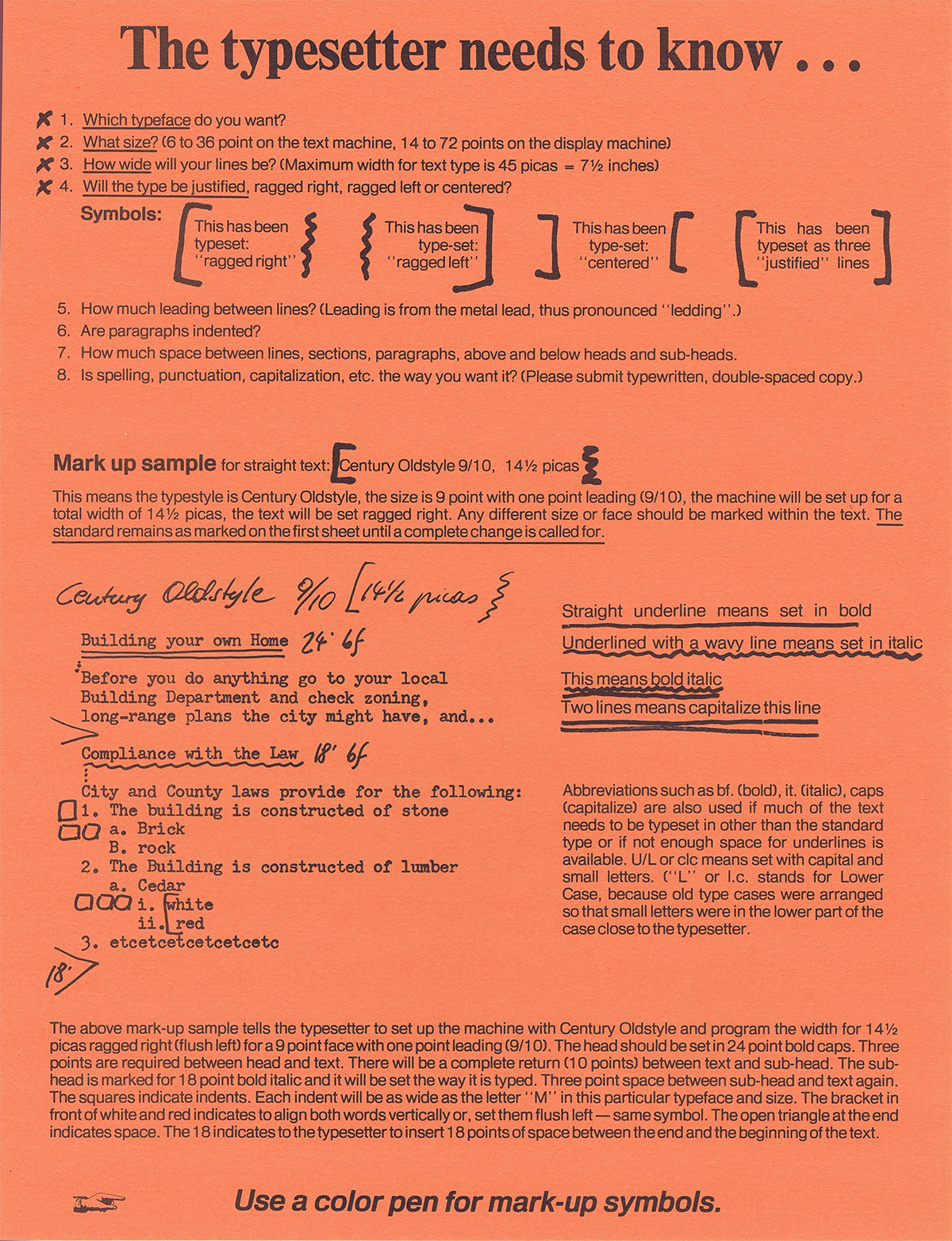
Eventually, after several years at Franklin Press, I got frustrated enough that I started offering a class for our customers in how to spec their type. It was pretty basic, but it got results: we got fewer jobs coming in with vague or inaccurate specs, and I kept getting more people signing up for the class. I suppose this was, although I didn’t realize it at the time, my first foray into teaching type.
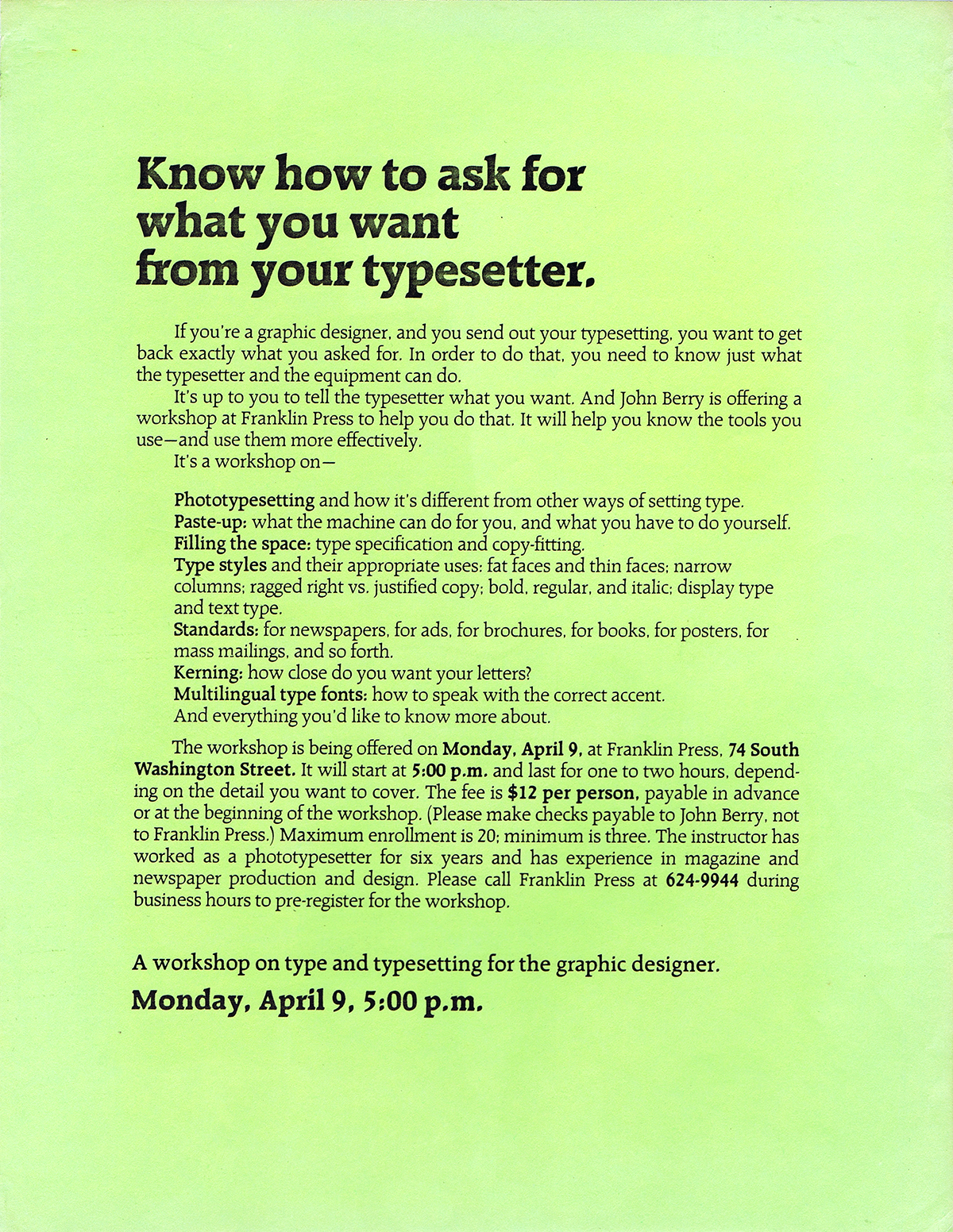
(One odd detail: in most composition houses, the way you’d indicate that something in the manuscript was to be set as italic was to underline it, and if you wanted it set as bold, you’d put a wavy line underneath. At Franklin Press, for some reason, these two were reversed. I never knew why. But we had to spell it out in a set of our own specs at the front of the shop, and often we had to double-check with the customer to make sure they meant what they had spec’d. This was another aspect of my type-spec’ing class, specific to our particular shop.)
We had to type in everything that we typeset. Copy came into the shop on paper, as a typed manuscript, whether the copy was articles for a newspaper or the text of an ad. The customer had to mark up that typed copy, using typesetter’s marks and instructions to tell us how they wanted it set. There were no captured keystrokes; nothing came to us on disk, and on the early machines nothing was stored in memory for future use. It was all typeset right away, on photo paper, and then that physical galley would be cut up and pasted up on a layout board, to be photographed and turned into “plates” for the printer.
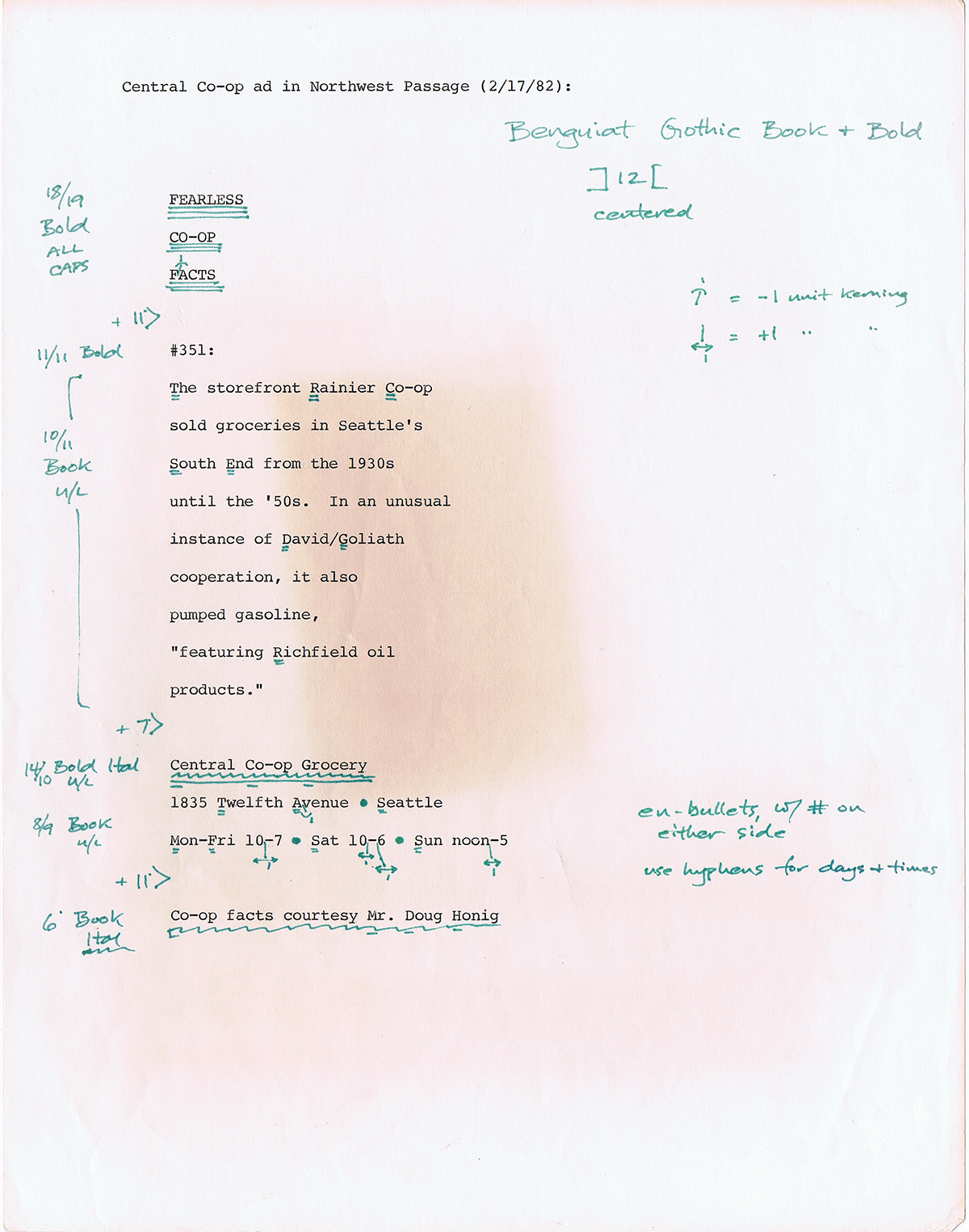
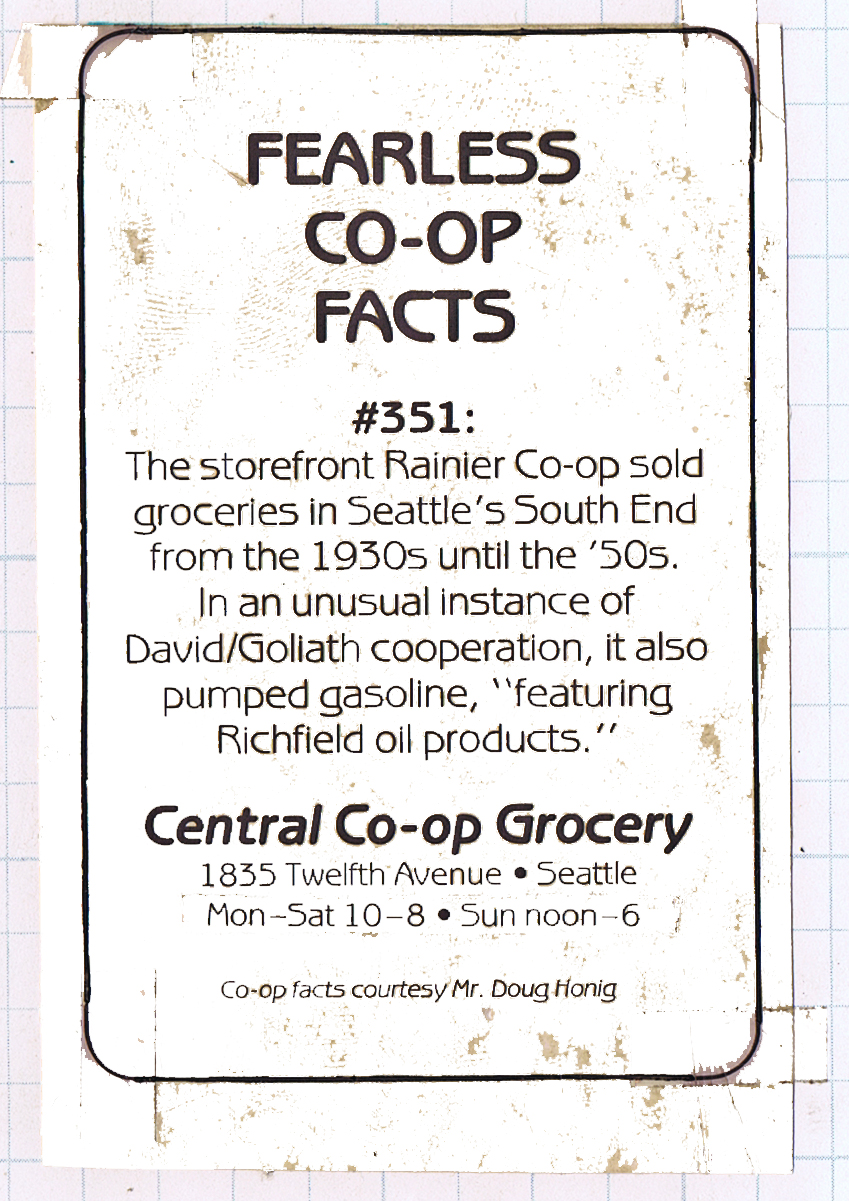
Later, when Jim invested in his first EditWriter, we were at last able to input more than a single line at a time, and it was possible to do some kinds of layout right on the machine. The formatting was all done with codes; there was no WYSIWYG in those days. But we got pretty good at guessing how what we typed in would look when it was printed out.
I remember the day that first EditWriter arrived in the shop. This was still, I think, at the Yesler Way location. The delivery guy had to manhandle this gigantic, awkward machine, with its distinctive bright Compugraphic blue exterior, into position in the shop; then it was up to us plug it in, turn it on, and figure out how to use it. Installation wasn’t part of delivery, and of course neither was instruction. But it was a wonder. An actual screen, with more than a single line! All those extra control buttons! Floppy disks! A new world awaited.
[Copyright 2020. Originally published in Medium.]

